
“Despite sporting the best hardware of any smartwatch so far, Samsung’s Gear still suffers from the rough edges of Android Wear, and lacks real-life utility.”
- Sharp, bright OLED screen
- Less hideous than competitors
- Wear works with any modern Android device
- More novel than useful
- Unreliable voice input
- Design still undeniably bulky, dorky
- Short battery life, charging cradle
- Randomly disconnects
“What’s a smartwatch?”
This is a question I now routinely answer as friends, bartenders, hotel concierges, and nosy strangers notice the glowing brick on my wrist and ask what it is, only to be dissatisfied by my reply. “Smartwatch,” it seems, has not reached the common lexicon. It’s no YOLO. No matter. My explanation goes something like this: It’s a watch that runs apps and talks to your phone, so you don’t have to pull your phone out of your pocket every 5 minutes. You can see who’s calling, get directions to the store, count your steps, and even reply to text messages with your voice.
Sounds awesome, right? But the first models, like Samsung’s Galaxy Gear, could only run apps made specifically for them, and only worked with a handful of phones. Google just fixed both issues with the release of Android Wear — a common platform that works with any late-model Android phone, and apps that work on any watch. Despite the lukewarm reception to its earlier smartwatches, Samsung was one of the first companies lining up to build a Wear watch: the Gear Live. It does have similarities to these earlier duds, but the new software makes it work entirely differently. So the question becomes: Was it just terrible software holding back smartwatches, or is the whole concept flawed? We lived with the Gear Live for two weeks to find out.
Two sides of the same coin
If you’re considering a smartwatch right now, you have two Android Wear options: LG’s G Watch and Samsung’s Gear Live. So why choose one over the other? Despite similar designs, the Korean competitors diverged on a couple of key points that make these watches considerably different. The most obvious, when you see them side by side, is the design. Samsung’s watch has a sleeker, more profiled look, while LG’s looks intentionally slab-like and angular. You can slap on any 22mm watchband on either device.
Less obvious, but more important, is the screen technology. LG uses an IPS LCD with 280 x 280 pixels, while Samsung uses an OLED screen with higher 320 x 320 pixel resolution. Looking at them side by side, there’s no question that Samsung’s is both brighter and sharper. But it also reverts to black and white when you’re not actively playing with it, while LG’s stays in color all the time. Those two both represents tradeoffs, but there are also two areas where Samsung clearly just wins outright. It’s the only one with a built-in heart-rate monitor (HRM), and at $200, it’s $30 cheaper than the $230 LG G Watch.
A metal matchbox for your wrist
There is no such thing as a “fashionable” smartwatch right now. The attention you’ll get with the Gear Live strapped to your wrist is kind of like what you would get with a tattoo of a Pokémon on your forehead — it’s more morbid curiosity than envy.
Wearing the Gear Live gets you the same attention a tattoo of a Pokémon on your forehead might.
You’ll find only one button on the Gear Live: a power button hidden low on the right side. It’s discreet, but poorly placed: I found the top of my hand jamming into it and resetting the watch from time to time.
Pair before you Wear
Before you can use any Android Wear device, even to tell time, you’ll need to connect it to an

After pairing, the Android Wear app also serves as a hub to control how your watch behaves. For instance, which app do you want to use when you tell the watch to take a note: Google Keep or some third-party app? You can set whether the watch keeps cards open on a dimmed screen, shows events from your calendar, and so on. It’s nice to be able to dial in your preferences on the phone instead of the watch, which just isn’t big enough for the task.
Charging and battery life
When the Gear Live runs low on juice, you’ll need to break out the included Micro USB charger and cradle. Yes, cradle. The Gear Live has five gold contacts on the bottom rather than a traditional Micro USB port, so you need to snap it into a tiny plastic cradle to charge it, which in turns accepts a Micro USB plug.

This will severely limit your on-the-go charging options, which wouldn’t be a problem, but we found that with frequent use, the Gear Live is only good for one day of play. By the end of some days, the battery was below 20 percent and crying for a recharge — it goes into a special monochrome mode. You’re probably recharging your smartphone’s pitiful battery on a nightly basis anyway, but the Gear Live will give you one more gadget to remember to plug in, and one more charger to pack when you travel.
The ins and outs of Android Wear
Think of Android Wear less like a mini version of
The point is: Android Wear is both totally dependent on your phone and totally subservient to it. You won’t be downloading “
In a quiet coffee shop where people are working, you won’t want to be the crazy jerk talking into his watch
When you have cards on your home screen, you can easily cycle between different ones by swiping up and down. Putting your palm over the screen acts like the Home button on a phone and brings you back out of whatever you’re doing to the main home screen. While you can swipe to find exactly what you’re looking for within any given app or card, Android Wear really wants you to talk to it to get anywhere in a hurry. From the
The uncomfortable realities of wearable tech
So in theory, Android Wear lets you access your favorite apps more easily, brings important notifications to your when you need them, and allows you to perform simple tasks by simply talking into your watch. Except in reality, you will more than likely want to punch your own wrist at some point during the day.
Voice: The biggest headache turns out to simply be getting around using Android Wear. Talking to a watch, it turns out, sucks. In a quiet coffee shop where people are working, you won’t want to be the crazy jerk talking into his watch. In a loud bar with music and conversation in the background, the watch both won’t understand you and will make you look like a tool. And even if you happen to be alone at home in complete silence, the hiccups of voice recognition routinely sabotage your requests. All it takes is one unusual name of a friend or destination and you’re out of luck. “Navigate me to Breakside Brewery” becomes “Navigate me to brick side brewery.” and you’re reaching for your phone. After it happens enough times, you’re tempted to just use the phone so you don’t have to roll the dice on voice recognition.
Remembering what apps you have: The biggest problem with apps is simply knowing you have them. Unlike on your phone, where a colorful grid of apps is only a tap away, Android Wear hides the master list of apps deep within the OS. You have to tap on the home screen to wake up the watch, tap again to get a list of optional voice commands, scroll past 14 different suggested voice commands like “Call a car,” to get to the bottom and then click “Start” to see a list of all your apps, which are sorted alphabetically. Then you must scroll some more.
Most apps aren’t compelling: Many of the apps just aren’t useful. Showing a QR code on your watch to board a plane sounds cool, but are you going to download the American Airlines app and set it all up just to save you the hassle of pulling out your phone on one airline? Reading a recipe from your wrist sounds cool, but the tiny screen can barely display enough to be useful, and you’ll still need to wipe off those greasy paws to swipe between each step. Getting your heart rate sounds cool, but … wait. No, that actually doesn’t sound cool at all. Why does an average person need to know their heart rate at any given moment?
Google Now cards: Google’s “cards” are convenient, but the seemingly random way they appear and disappear will drive control freaks crazy. If you feel your wrist buzz from an incoming email, but don’t have time to scan it, it might not be there when you get a chance to look. If you swipe it away but need to see it again, there’s no way — even with voice commands — to pull it back up. Google Now decides what you see and don’t see, and there’s no way to choose and card you want to keep around and pin it there. We also found the watch disconnecting randomly from our phone at times, which only aggravated other problems. There’s nothing like trying to show off your watch by talking into it, only to have it do nothing, then reconnecting it, repeating your request, and having it totally misinterpret your request.
Conclusion
I intentionally took my time with the Samsung Gear Live review because I wanted to see how it could integrate into my life, rather than just evaluating it on what it could and couldn’t do out of the box.
The truth is, after two weeks of trying to embrace it, I have to force myself to use it for tasks I would rather do with my phone, it routinely fails when I need it to do something critical, and I’m anxious to take it off at the end of the day. Android Wear solves some of the early platform issues that have prevented smartwatches from prevailing in the past, but it’s still littered with interface problems, and the fundamental problem remains that smartwatches just aren’t that useful.
You don’t need this watch. If you insist on a smartwatch right now, Samsung’s Gear Live is unquestionably the best choice. But that’s kind of like saying a canary is a better pet than a finch: They’re both just annoying small birds that will chirp at you all day long. Go buy a dog already. Maybe, like a good canary should, the Gear Live will die early and give Samsung a warning to get out of the smartwatch mine.
Highs
- Sharp, bright OLED screen
- Less hideous than competitors
- Wear works with any modern Android device
Lows
- More novel than useful
- Unreliable voice input
- Design still undeniably bulky, dorky
- Short battery life, charging cradle
- Randomly disconnects










